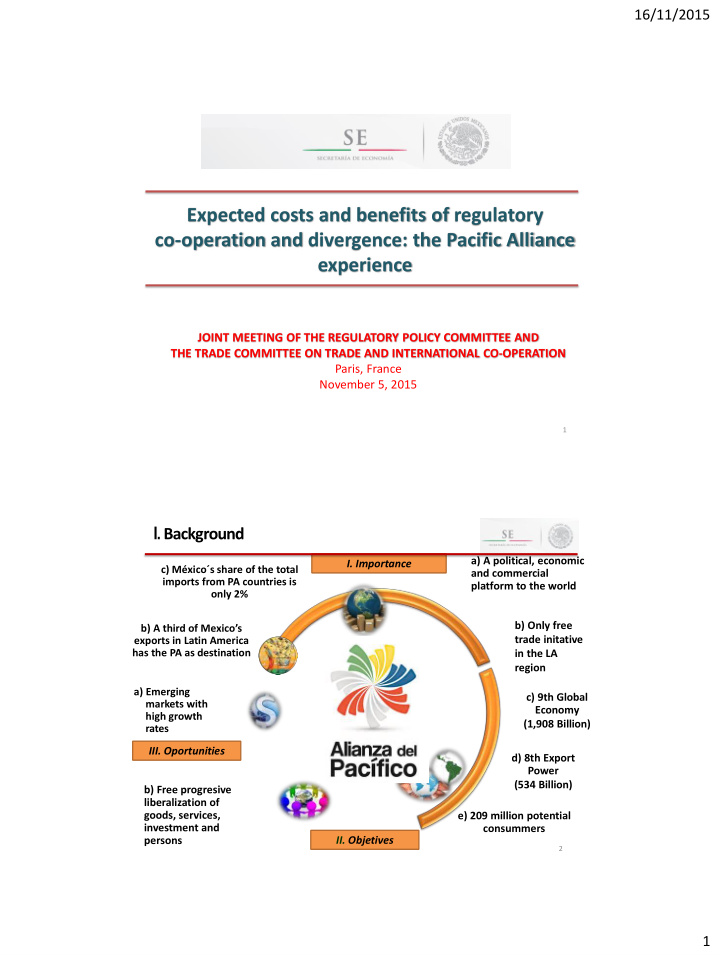



16/11/2015 Expected costs and benefits of regulatory co-operation and divergence: the Pacific Alliance experience JOINT MEETING OF THE REGULATORY POLICY COMMITTEE AND THE TRADE COMMITTEE ON TRADE AND INTERNATIONAL CO-OPERATION Paris, France November 5, 2015 1 I. Background a) A political, economic I. Importance c) México´s share of the total and commercial imports from PA countries is platform to the world only 2% b) Only free b) A third of Mexico’s trade initative exports in Latin America has the PA as destination in the LA region a) Emerging c) 9th Global markets with Economy high growth (1,908 Billion) rates III. Oportunities d) 8th Export Power (534 Billion) b) Free progresive liberalization of goods, services, e) 209 million potential investment and consummers persons II. Objetives 2 1
16/11/2015 I. Backgorund (Cont.) Integration initative launched on April 28, 2011 by Chile, Colombia, México and Perú. 34 Observers from all regions. Panama may join as full members in the future. Mexico’s participation in Alianza del Pacífico is part of a wider strategy to increase integration in Latin America. The Alianza del Pacífico is working in the following areas: • Trade and integration • Services and capitals • Business persons movility • Cooperation June 6th, 2012: Framework Agreement (Acuerdo Marco). February 10th, 2014: Additional Protocol (Protocolo Adicional) with 19th Chapters). II. Regulatory Cooperation in the AP Technical Barriers to Trade • Objectives: • increase and facilitate international trade; • ensure that standards, technical regulations and conformity assessment procedures do not create unnecesary barriers to trade. • Parties recognize the existence of differences among their respective conformity assessment procedures and commit to work to make them compatible to the greater extent possible. • Ambitious transparency and regulatory cooperation commitments. • Includes the posibility of launching the negotiation of specific Annexes that will be implemented as a part of the Technical Barriers to Trade Chapter. • However, the Regulatory Cooperation activities preceded the negotiation of the TBT and SPS disciplines. 2
16/11/2015 II. Regulatory Cooperation in the AP (Cont.) • The Parties have agreed on a “ Regulatory Cooperation Pathway ”, which consists of a specific procedure to select initiatives of interest for the four countries. • This Pathway aims to facilitate international trade through the establishment of two-year programs in specific sectors of interest agreed by the four countries. • It is based on a public consultation process and the involvement of the relevant regulatory authorities and the private sector. • The first Workplan was focused in the following sectors: - Pharmaceutical products: with the objective of streamlining the registration of this products in each of the countries. - Cosmetics: with the following objectives: – I. Armonized definition of cosmetic products; – II. Establishment of a “ market surveillance system ”; – III. Elimination of the free sale certificate; – IV. Homologation of the ingredients ’ revision systems; – V. Armonization of labeling requirements; – VI. Armonization of good manufacturing practices requirements. II. Regulatory Cooperation in the AP (Cont.) Results of the First Regulatory Cooperation Work Plan - On June 20 th , 2013 the four countries’ sanitary authorities subscribed the Inter- institutional Cooperation Agreement on Pharmaceutical Products . - Regarding the cosmetics sector, from 2012 to 2014, the TBT Working Group, supported by the four countries’ sanitary authorities and industry, worked on a document that formalized the objectives agreed to by the four countries. - On July 3, 2015, that document was signed as the “ Annex on the Elimination of Technical Barriers to Trade in Cosmetic Products. ” . The document will be incorporated into the Treaty as an Annex to the TBT Chapter - Nowadays, the TBT Working Group has already undertaken consultations and is defining the contents of the Second Regulatory Cooperation Work Plan. The Group expects to define, during 2015, the specific sectors in which the Work Plan will focus. 3
16/11/2015 II. Regulatory Cooperation in the AP (Cont.) Criteria to include sectors: • Medical Devices - Coverage • Pharmaceutical products - Consensus • Food Supplements - Feasibility • Telecommunications - Expected outcome Equipment • Personal care - Impact in Trade. products • Paints II. Regulatory Cooperation in the AP (Cont.) • The following methodology was suggested: iii. Generate ii. Is 2. To modify i. Attends Yes Yes Yes unnecessary armonized a risk to elliminate costs Usefulness internationally unnecessary of the costs No No No regulation 1. To confirm or 4. To cancel 3. To modify in order create to armonize with international standards • Unnecessary transaction costs Measurement • Underinvestment in the specific sector of the • Productivity below international references economic • Economic impact: measures as a GDP porcentage. impact • Frequency of the use and coverage of the regulation . 8 4
16/11/2015 III. Lessons learned 1. To define specific activities and concrete goals, with timeframes and well identified steps. 2. To involve and act as a result of an interest from private sectors in all the relevant Parties. 3. To prefer “ measures ” rather than “ sectors ” to define activities. 4. To create follow up and assessment mechanisms. 5. To formalize commitments between regulators III. Lessons learned (Cont.) 1. What may work for one sector, may not for another. 2. To obtain mandates and empowerment from the Political Level and High Level Officals. 3. To be flexible with the timeframes and deliverables, 4. To find balances/reciprocity in general and not necessarily in each activity. 5. Lack of methodology and criteria to determine the economic- impact of each activity: is it relevant? 5
16/11/2015 Juan Antonio DORANTES Director General for International Trade Rules Secretariat of Economy / MEXICO “ juan.dorantes@economia.gob.mx ” 6
Recommend
More recommend